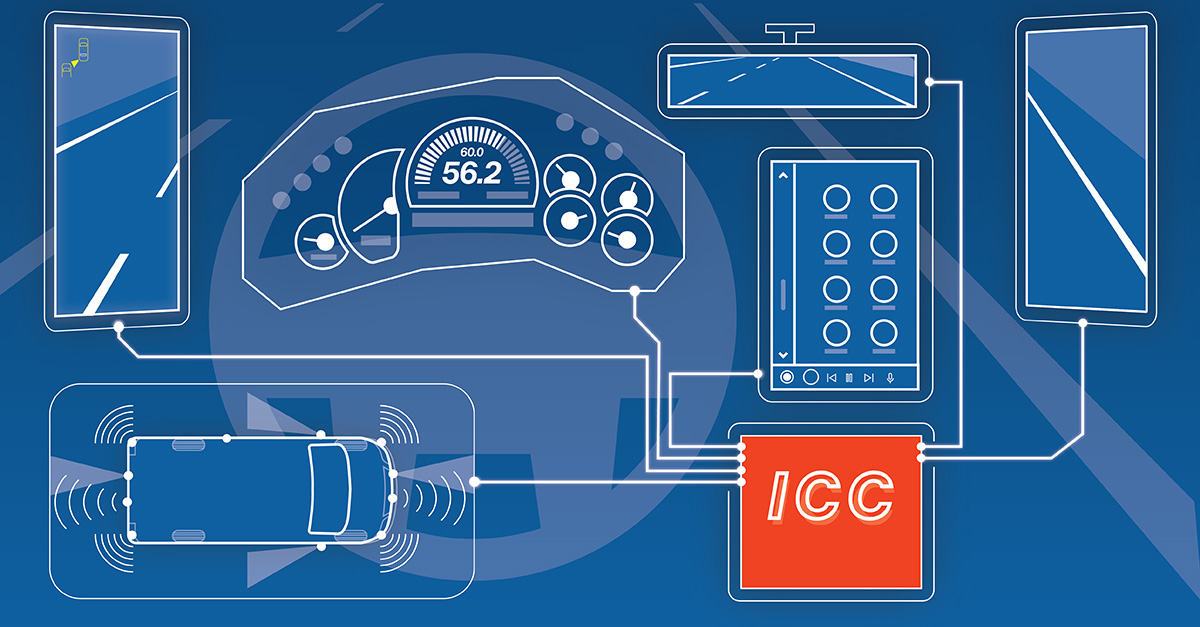Less is More: Integrated Cockpit Controller can Streamline the In-Cabin UX Redesign
By overcoming the need for multiple Electronic Control Units (ECUs), the latest generation of Integrated Cockpit Controller (ICC) is enabling richer in-cabin experiences and more efficient Commercial Vehicle (CV) design and manufacture
For a fast-growing number of CV fleet operators, redesigning the in-cabin user experience is a priority. In many parts of the world, recruiting and retaining drivers is becoming more difficult, and improving the working environment is an obvious starting point to addressing such challenges. In addition to enhancing levels of comfort, this renewed emphasis on employee welfare is also encompassing safety, with emerging regulations and greater awareness of the potential for new technology to cut accident rates encouraging adoption of systems such as a driver sensing for distraction and drowsiness detection. And, of course, fleet operators are always seeking to improve return on investment. Here, the latest developments in infotainment are particularly exciting, with the new Android Automotive OS offering seamless access to a wealth of third-party apps, direct from a fully integrated head unit. For operators, this includes tools for streamlining fleet management and boosting fuel efficiency. As for OEMs, heightened expectations of the CV cabin are creating real opportunities to add value and differentiate products. However, there are potential pitfalls too, with proliferation of new features threatening to load additional cost onto manufacturing processes. Fortunately, a new generation of ICC (Integrated Cockpit Controller) is tackling these issues head-on, enabling capable and agile platforms that support rich functionality, while simultaneously realizing significant efficiencies in design and production.
Transforming the in-cabin user experience
With an array of powerful factors at work, the CV cabin is evolving rapidly. High definition displays are replacing traditional analog instruments. Cabin environments are beginning
to reflect the 24/7 connected world that now dominates so much of modern daily life. Consequently, infotainment systems are migrating to more familiar, intuitive interfaces, and incorporating ubiquitous connectivity protocols such as Bluetooth and
Wi-Fi. Emerging regulations are also driving change. The latest initiatives in the EU, for example, are set to compel all new vehicles to incorporate a series of active safety systems, with implications that include the need for cameras in the cabin.
Addressing ECU proliferation
Until recently, implementing new features on this scale almost invariably involved a corresponding increase in the number of ECUs required – essentially one for each individual system.
Inevitably, the result is higher build costs: more components, greater design complexity and extra potential for errors on the production line. On top of that, additional ECUs demand additional space, as well as contributing unwanted weight.
The compelling alternative
Fortunately, the ICC represents a compelling alternative. Replacing multiple ECUs with a single, powerful computing platform capable of supporting an array of in-cab functions, today’s leading
ICCs incorporate architectures with discrete areas to enable several displays and in-cabin camera modules, for example. And it’s not just about consolidating ECU requirements; ICCs are facilitating a step change in performance, and scalability
to meet individual customer requirements for memory, graphics and computational speed.
Cutting cost and mass
Although the ICC may come at a premium to an ECU, by eliminating the need for several such components, it simplifies overall design. As a result, compared to a traditional ECU-based approach, it is
possible to realize cost, space and weight savings. But the advantages do not stop there, particularly for CV OEMs managing long product lifecycles, relatively low production volumes and the need for flexibility to meet individual customer demands.
By employing a single computing platform rather than multiple dedicated ECUs, OEMs allow themselves far more freedom to meet varied and changing cabin user experience requirements. By embedding a common, highly scalable, future proof solution in the
heart of the vehicle, they are facilitating evolution without the need for major, costly and time-consuming design changes.
Embracing change
At the risk of cliché, the ICC offers OEMs and their customers a genuine win-win proposition. Enhanced in-cabin experiences can be combined with significant manufacturing efficiencies. Furthermore,
OEMs working with Aptiv are realizing benefits that extend well beyond a comprehensive portfolio of high-performance ICCs. Crucially, the company’s core competencies embrace all the key technologies currently transforming the CV cabin user experience,
including industry-leading active and advanced safety systems, infotainment head units capable of integrating Android Automotive Services, and interior sensing systems for driver drowsiness and distraction detection. In addition, with Aptiv these
solutions are backed by deep understanding of the unique demands of the sector. As a result, they reflect not only the very latest expectations of fleet operators and their employees for a far more sophisticated user experience, but also the on-going
need for products that can reliably withstand the harsh environments and punishing product lifecycles that are very much typical of the CV domain.
